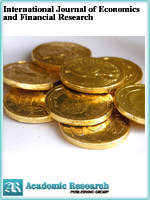International Journal of Economics and Financial Research
Online ISSN: 2411-9407
Print ISSN: 2413-8533
Print ISSN: 2413-8533
Quarterly Published (4 Issues Per Year)

Archives
Volume 4 Number 1 January 2018
On the Measurement of Overconfidence: An Experimental Study
Authors: Markus Spiwoks ; Kilian Bizer
Pages: 30-37
Abstract
This study addresses two methods commonly used to measure overconfidence and examines their reliability. It is shown that traditional methods of assessing subjective certainty concerning a given forecast can contribute to a systematic overestimation of overconfidence. It also becomes apparent that a common approach measuring relative overconfidence can cause a distortion of scientific results. This is particularly valid for study groups in which female and male participants are not equally represented.
What Determines The Financing Supply of Islamic Banks? A Multicountry Study
Authors: Shakeel Riaz ; Dr. Talat Hussain
Pages: 22-29
Abstract
Smooth functioning a bank depends on the stability of stream of returns that it gets from its financing decision. This study is an attempt to showcase the reason for idling or shortage of funds and the factors for the case of Islamic banking. This effort will determine the strategy which can boost the financing in the economy, for this, this study has used the panel data of full-fledged Islamic banks from countries Pakistan and Malaysia, spanning to several years and based on several banks. Based on the analysis of internal and external factors of Islamic banks, it can be seen that increase in the market rate leads to decrease in demand of financing while the increase in deposits and equity do not show a proportional increase in financing which hints that there is excess liquidity available in the Islamic banks. On the positive side, it is evident that increase in the economic activity boosts the demand for Islamic financing.
Government Intervention and Economic Development: Lessons from Songhai Development Initiative Farm in Rivers State, Nigeria
Authors: Agbarakwe, Ugochukwu Henry ; Anowor, Oluchukwu F
Pages: 13-21
Abstract
This study sets to assess the effect of government intervention on economic development adopting Songhai Development Initiative Farm in Rivers State of Nigeria as a case study. It adopted the survey design with the instruments of personal observations, interviews and questionnaires to collect the required data. The data has internal consistency of 0.87, test-retest reliability of 0.85 (p < 0.001), split-half reliability of 0.82 (p < 0.001). The mean of 3 points was chosen as a cut off point for accepting or rejecting each of the items in the Likert’s scale. The Chi-square was also used to test the hypothesis. All items have mean (X ̅) that are higher than the cut-off mark and this is supported by low standard deviation for all the items which depicts a low variation of the observations from the mean. With the calculated Chi-square greater than the table value (i.e 30.34957 > 21.026) in absolute term, the study concludes that there is a significant relationship between Songhai Development Initiative Farm and the economic development. It, therefore, recommended that such and similar government direct involvements in the agricultural and other sectors should be encouraged for optimum benefits in output, job creation, income, social welfare and technological advancement.
Agriculture Public Expenditures and Growth: The Case of Togo
Authors: Koffi Yovo
Pages: 7-12
Abstract
This paper analyzes the trends and evolution of public expenditures in the agriculture sector in Togo, as well as its impact on the growth of agriculture during the period 1985–2015. To this end, we constructed a model capturing both the effect of the volume and the composition of public expenditures in Togolese agriculture. The results highlight the fact that the public investments on agriculture had a positive impact on agriculture growth, whereas public expenditures on fertilizer subsidies had the opposite effect. The study recommends that to revitalize the agriculture sector, the public expenditures should be directed at improving the provision of public investments and services rather than at subsidizing private inputs.
Analysis of Ghana,s Imports and Exports
Authors: Alice Constance Mensah ; Ebenezer Okyere
Pages: 1-6
Abstract
The long-run relationship between exports and imports has been the subject of intensive research in developed and developing economies. This relationship is of importance due to the fact that it reflects the stability of foreign trade situation of a country. The main objective of this paper is to study and investigate the long-run relationship between exports and imports in Ghana’s economy. A time series econometric techniques of unit root tests, Johansen cointegration and error-correction mechanism were applied. Annual data for real exports and real imports for the period 2002 – 2015 were used. The results of ADF unit root tests suggest that the two variables export and imports are integrated of order one. Johansen cointegration test revealed that, a long-run cointegrating relationship exist between exports and imports in Ghana. The error-correction model found a long-run unidirectional causality from imports to exports. This means that the short run fluctuations between exports and imports are sustainable since, in the long run, they will eventually converge towards an equilibrium state. The study confirms that Ghana is not in violation of its international budget constraints, and macroeconomic policies have been effective in bringing exports and imports into a long-run equilibrium.



